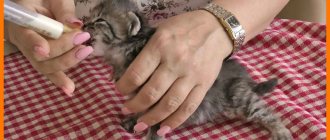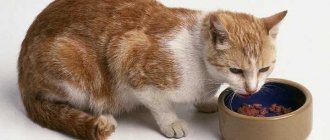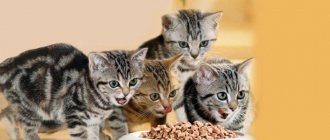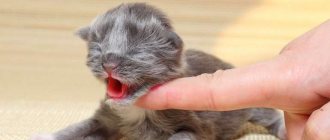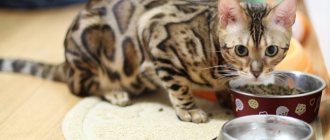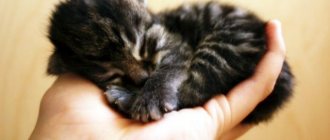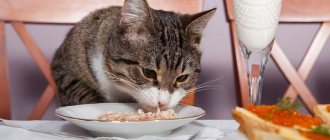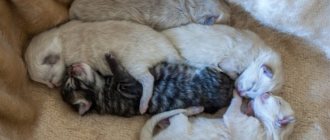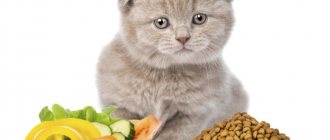What's wrong with a cat - reasons for abandoning offspring
When a cat abandons her offspring, the situation becomes extremely tense, but there is no need to panic in advance. You need to at least try to understand what is wrong with the cat. By eliminating the reasons why the young mother abandoned her offspring, you will save yourself from the need to feed newborn kittens.
If the cat gave birth for the first time, most likely, ignoring feeding is due to stress.
Watch your pet carefully, if she simply ignores the kittens and gets worried, take the kids away for a while and let the cat come to her senses. Just a few hours later, you will find that the cat has begun to wander around the house in search of a more secluded place for the nest.
Make every effort to ensure that your pet finds a safe hiding place, invite her to crawl into a closet, under a bed or other secluded place. If the cat climbed into the shelter, lay down and began to purr, act: cover the new nest with soft pieces of fabric, calm the pet down and try to bring one kitten to its face. If the cat does not show aggression, place the baby near the nipples.
The reason why a cat can not only refuse to feed, but also kill her own kittens is postpartum eclampsia. The condition is associated with a sharp decrease in calcium levels in the blood. Postpartum eclampsia is a hereditary disease, but its manifestation after the first birth cannot be predicted.
If you notice that the cat has a fever, there are any disorders of the central nervous system or other alarming symptoms, for the sake of safety, take the kittens away from her.
Postpartum eclampsia can be treated, the main thing is to act quickly!
Immediately after birth, while the body is recovering from stress, the cat may develop insulin shock. The cat falls into a lethargic state due to constantly rising blood sugar levels. The condition can be successfully treated with emergency care, but kittens must be taken away and artificially fed during recovery.
If the cat looks healthy and calm, but ignores the kittens, most likely the reason is their non-viability. This can happen if birth occurs 1-2 weeks ahead of schedule. Unfortunately, premature kittens most likely will not survive, but you can try artificially feeding them.
When do kittens need artificial feeding?
The ideal situation is as follows: the cat cares for and feeds the kitten until it is approximately 8 weeks old. Only then can you separate the baby from his mother. But there are times when human intervention and help is required. Reasons why this may happen include:
- death of a cat;
- lack or deficiency of milk in her;
- mastitis and inflammation of the uterus in a cat;
- eclampsia in a cat, that is, calcium deficiency;
- psycho-emotional deviations of the animal.
Sometimes the mother feeds the kittens regularly, but the babies still need complementary foods. This situation may arise if the litter is very large. It happens that a weak kitten is born, which quickly gets tired when sucking - in this case, it also needs additional nutrition. How you manage to feed a kitten without a cat or simply intervene a little in the process will determine its future health.
Rules for feeding kittens without a mother
When becoming a guardian of newborn kittens, it is important to understand that feeding, although key, does not guarantee survival. The rules for feeding kittens without a mother are to perform the following functions:
- Heating.
- Maintaining cleanliness.
- Taking care of your health.
- Feeding.
Until about one and a half months of age, babies' thermoregulation does not work fully, so the nest needs to be maintained at a constant temperature of at least 29–30 degrees. The normal temperature for a cat ranges from 38 to 39 degrees; kittens' temperatures are usually higher.
Before and after each feeding, inspect the kitten's skin and coat. The coat should be clean and the skin should be light. Matted fur indicates health problems, while redness on the skin may indicate a food allergy.
Be sure to massage your kitten's belly and genital area before and after feeding. Without this procedure, babies under one month of age cannot empty their bowels and bladder. If this rule is ignored, rapidly increasing intoxication will kill the kitten within 24 hours.
The issue of feeding is the most complex and multifaceted. Even newborn kittens can suffer from food allergies or not fully digest their food. Let's take a closer look.
How to feed a newborn kitten
Newborn kittens cannot eat on their own, so they have to be force-fed. How to feed newborn kittens without a cat? For these purposes, use a pipette or a small feeding bottle. Sometimes it works well to administer food using a medical syringe.
How to feed newborn kittens: for convenience, it is better to place the little orphan on your lap or create a cozy bed with sides made of warm and soft fabric. The baby's position should be as natural as possible; the best option is lying on his stomach. During feeding itself, you can slightly raise the front part of the body so that the kitten is at an angle of 45 degrees. Next, we bring a bottle with a nipple and our cub, sensing the smell of food, will attach itself to the bottle and the sucking reflex will work. Do not press on the bottle or pipette; in this case, the kitten may choke.
Try to feed so that the baby sucks and does not swallow air, otherwise the excess amount of gas in the stomach will bother the pet.
When the baby is full, he will fall asleep or simply stop sucking.
After you finish feeding, massage your tummy - this will stimulate intestinal motility.
What does it take to feed newborn kittens?
If your cat is preparing to become a mother, everything you need to feed the kittens should be purchased in advance. If you suddenly become the guardian of a blind kitten, improvise, but try to provide the baby with the maximum chance of survival.
To fully care for a newborn kitten you will need:
- A heating pad, preferably an electric one, with a regulator. For the first few days, instead of a heating pad, you can use plastic bottles filled with hot water and wrapped in terry towels.
- Large supply of cotton and terry cuts.
- Gauze cuts and swabs, cotton sponges.
- Moisture-wicking diapers.
- The gloves are disposable.
- Scales.
- Feeding bottle.
- Anti-colic drug (for children).
- A small box is a nest.
- Thick fabric that allows air to pass through well - cover the box so that the kittens are in the dark and do not worry.
Newborn kittens instinctively strive to be closer to their mother, that is, to something big, warm and fluffy. When stressed, kittens may squeak even when they are not hungry. By confusing stress and hunger, you can overfeed your babies. To make the nest more comfortable, you can place a small stuffed toy in it or wrap a warm water bottle in a piece of soft, fluffy fabric.
Caring for newborn and older kittens
To create comfortable conditions for furry babies, you need to take care of their place of residence. A large basin or cardboard box will serve as a “dwelling”, but you will have to constantly ensure that it does not get wet. For this purpose, absorbent material is purchased that absorbs excess moisture.
In the first days of life, kittens especially need warmth, so it is advisable to install a heater near their place of residence. If you don't have one, use a heating pad wrapped in a towel or a hot water bottle. Don’t forget: the minimum ambient temperature in the first two weeks of a baby’s life is kept at 30° C. After 14 days, lower the temperature to 24° and do not change it for another three weeks.
At three weeks of age, babies begin to try to walk: be careful that they do not fall out of their nest and get injured. The first walks should take place under your watchful supervision.
Try not to let kittens onto the carpet: they do not yet know how to retract their claws and therefore constantly cling. In worst cases, the baby may be injured.
At the fifth week of life, kittens see well and move actively. Then they are introduced to the first complementary foods. By 6 weeks of age they can eat solid food, and at 8-10 weeks they can be given to new owners.
To monitor the development of kittens, you will need an accurate scale. Weighing babies is necessary for:
- calculating the volume of daily portions;
- tracking growth rates.
If your kitten is not gaining weight well, you should consult your veterinarian. Perhaps the baby is malnourished or sick with something.
Feeding methods
There are several ways to feed kittens; your task is to choose the right one for each baby. The first, optimal feeding method involves using a special plastic bottle with a shortened nipple. These bottles are sold in pet stores and are often included in the cat milk replacer starter pack.
If you don’t have a bottle or you can’t feed the kitten from it, you can try using a syringe or pipette. Using a pipette is quite convenient to feed a weakened kitten if it has no or poorly manifested swallowing reflex. The milk is applied in drops to the tongue and then flows down to the throat. Pipette feeding should be done very slowly as the kitten may choke.
A syringe is used if the kitten sucks very hard on the bottle and the nipple sticks together. It is better to choose a syringe with a rubber cap on the piston. When using a syringe, care must be taken as sudden movement of the plunger may cause milk to be injected into the respiratory tract.
How to feed a small kitten: features and rules
There are certain rules and nuances of feeding a kitten. This applies to both the feeding regimen and procedures after it.
What things will you need?
To feed a kitten, you will have to purchase some items. A bottle with a special nipple will be more convenient for you and better for the animal: such a thing is sold in a veterinary pharmacy. It has an anatomically correct shape and resembles a cat's nipples.
You can feed newborn kittens without a cat either with a pipette or with a syringe without a needle. But this option is undesirable, since during feeding, air may enter the esophagus or milk may enter the respiratory tract, causing the animal to choke or regurgitate. It is very important to wash and sterilize items after each feeding.
Stages of the procedure
When everything you need has been collected and sterilized, dilute the mixture according to the instructions and heat it. It is not recommended to do this in the microwave - the mixture may warm up unevenly - it is better to heat it in a water bath.
Check your pet's body temperature. If the paws are cold, the kitten is cold, which means the food will be digested much worse. The baby must be kept warm at all times. To do this, place a heating pad wrapped in a towel or a bottle of hot water in his box or house.
When you are sure that the kitten is warm, you can proceed directly to the feeding process. To do this, lay a towel on your knees, carefully lay the kitten on its stomach and lift its head a little - this is the position in which kittens feed from their mother. For the very first time, you should moisten the nipple's spout with milk so that the baby smells the food and begins to eat.
How to determine if a kitten is full
Both conditions are extremely undesirable and even dangerous for a baby: underfeeding and overfeeding. If he doesn't get enough food, he doesn't gain weight well and appears lethargic. Overeating is indicated by loose stools in yellow, green and gray shades. You can visually determine whether the kitten is full in the following way: extend your finger to it. If the animal begins to suck, then it is not full.
The baby’s behavior is also an indicator. If the kitten is full, he simply turns away and falls asleep, sometimes milk bubbles come out of his mouth, if not, he squeaks, crawls and looks for a pacifier.
What to do after feeding
During the process, try your best to ensure that the animals are calmed by your voice. Talk to them and be sure to pet them, and after feeding, wipe off any remaining food from their faces.
At the end of feeding, lightly press the kitten's back against your stomach and gently stroke its tummy. With these actions you stimulate belching and start the process of digesting food.
To prevent kittens from suffering from constipation, it is necessary to massage their anus. This is done with cotton pads or ear swabs, which are dipped in Vaseline.
Artificial stimulation of peristalsis does not always help, and babies experience stool retention. In this case, you need to give an enema, but it is better to do this under the supervision of a veterinarian - leave the procedure to him for the first time, later you will learn how to give enemas to kittens yourself.
Feeding mode
Veterinarians recommend feeding newborn kittens on demand. Healthy kittens are active, moving around and squeaking when they are hungry. If the kitten is weakened, it will not be active and may die in its sleep.
If you are not sure that the kitten will ask to eat, it is better to stick to the feeding regimen:
- From birth to 14 days, kittens eat 10 times a day without a break for night sleep.
- From 14 to 18 days, kittens eat 9 times a day without a break for night sleep.
- From 18 days to 1 month, kittens eat 8 times a day without a break for night sleep.
- From 1 to 2 months, kittens eat 7 times a day.
- From 2 to 3 months, kittens eat 6 times a day.
The number of feedings given in the list above is arbitrary. The frequency of food intake, the duration of the break and the speed of saturation of kittens directly depends on the milk replacer, more precisely its energy value and fat content.
After feeding
After eating, small kittens, like infants, have the habit of burping. Therefore, after the feeding process is completed, before starting the massage, the babies need to be placed on their tummy and gently stroked on the back until they burp.
If the kitten cannot burp, you need to keep its face straight and motionless. If this measure does not produce results, it is worth trying to feed the baby again; perhaps he did not receive his food allowance.
Milk replacers and formula for newborn kittens
When feeding a kitten, you need to make a fundamental decision: natural milk or milk substitutes and formula. There are pros and cons to both options, and the main differences lie in the energy value of the food.
The daily food intake in milliliters is calculated based on the weight of the kittens:
- From birth to 7 days – 30 ml per 100 g. body weight.
- From 7 to 14 days – 35 ml per 100 g. body weight.
- From 14 to 21 days – 40 ml per 100 g. body weight.
- From 21 to 28 days – 45–48 ml per 100 g. body weight.
- From day 28 – at least 50–53 ml per 100 g. body weight.
Until the kitten is 2 weeks old, you will not be able to determine whether you are overfeeding it. The reason is that at such a young age, kittens suckle instinctively. The baby can eat food even while sleeping. The only reliable way to track the rate of formation and growth is regular weighing.
Industrial cat milk substitutes
The best choice for feeding newborn kittens are industrial cat milk substitutes:
- Katzenmilch.
- Hartz milk powder.
- Babycat Milk (Royal Canin).
- Beaphar Kitty-Milk.
- Gimpet Cat-Milk.
- Nutri Vet.
- Just Born.
- Nurturall-C.
- Pet Lac.
When deciding to feed a kitten with a substitute, it is important to understand that it is highly undesirable to change the type of food before 2-4 weeks of age. Changing the type of diet justifies the risks only in the event of a food allergy. In addition, carefully read the instructions for the milk replacer; some “baby” products are intended for kittens older than 2-3 weeks.
Baby formula
From two weeks of age, you can use infant formula for kittens:
- Nutrilon.
- Nestozhen.
- Little Istrinsky.
- Baby.
It is important to understand that formulas developed for children contain much more carbohydrates and lactose than a kitten needs.
On the one hand, such a composition creates a more aggressive intestinal microflora, which will allow the kitten to successfully digest supplementary food, on the other hand, it can lead to problems in the gastrointestinal tract. When choosing a formula, give preference to products designed for newborns that do not contain sugar or other additives.
Scott's Kitten Mix
Before industrial cat milk substitutes began to be produced, kittens were successfully fed with homemade formulas. Scott's kitten mixture contains yeast, which gives a good chance of eliminating digestive problems associated with dysbiosis.
Recipe for 1 kg body weight:
- Homemade, not separated cow's milk – 50 g.
- Powdered milk – 15 gr.
- Dry yeast (nutritional) – 3 gr.
- Chicken egg (yolk and white) – 50 gr.
- Chicken egg white, beaten until foamy – 50 g.
- Sunflower oil, refined – 1 gr.
- Glucose (powder or pharmacy) – 4 g.
Preparation:
- Place all ingredients in a ceramic bowl.
- Mix the mixture thoroughly with a whisk until a homogeneous mass is formed.
- Using a syringe, take out the required amount of the mixture.
- Warm the mixture to 38 degrees before feeding.
The mixture is stored in a refrigerator in a ceramic container covered with cellophane and paper. Shelf life no more than 3 days!
Tailing mix for kittens
Tylinga kitten mixture is more suitable for babies who suffer from colic and bloating. Recipe for 1 kg body weight:
- Homemade, not separated cow's milk – 25 g.
- Powdered milk – 5 gr.
- Glucose (powder or pharmacy) – 2 g.
- Vitamin supplements for kittens (industrial) – 1 g.
Preparation:
- Place all ingredients in a ceramic bowl
- Mix the mixture thoroughly with a whisk until a homogeneous mass is formed.
- Using a syringe, take out the required amount of the mixture.
- Warm the mixture to 38 degrees before feeding.
The mixture is stored in a refrigerator in a ceramic container covered with cellophane and paper. Shelf life no more than 3 days!
What food and how much should you give your kitten?
The daily weight gain of a kitten is about 20 grams. Each gram of increase entails an increase in the amount of mixture by 4-5 grams. A more detailed feeding schedule is as follows.
A kitten aged 1-2 days should drink 30 grams of mixture per 0.1 kg of weight. Feeding should be done every 2 hours. A kitten aged 2-4 days should drink 30 grams of mixture per 0.1 kg of weight. Feeding should be done every 2 hours during the day and every 3 hours at night. A kitten aged 5-13 days should drink 38 grams of mixture per 0.1 kg. Feeding should be done every 4 hours. A kitten aged 13-22 days should drink 46 grams of mixture per 0.1 kg of weight. Feeding should be done every 4 hours. From the 15th day, give the kitten liquid milk porridge with an egg. From day 22, offer other products - beef and fish minced through a meat grinder, baby food, low-fat cottage cheese, egg yolk.
After feeding, check that each kitten has been fed. Well-fed kittens sleep, but hungry kittens scream, crawl away and try to suck the outstretched finger. Be sure to feed hungry kittens. After 4 weeks, introduce the kitten to the bowl by wetting its mouth with the mixture and bringing it to it
Vitamins and supplements for artificial kittens
If there is growth retardation, even newborn kittens are given vitamins and supplements in their diet. In addition, vitamin supplements are listed in the Tailinga mixture recipe. The problem is that almost all complex drugs are intended for kittens older than 2 months. The only way out of this situation is to grind vitamin supplements and dose them by weight.
Note! Some manufacturers produce vitamin supplements in powder form, but read the instructions carefully so as not to make a mistake with the age category.
Preparing a kitten feeding kit
To feed a kitten without a cat, you need to prepare everything you need, so that later it doesn’t turn out that something necessary is missing at that very moment.
First of all, you need to purchase auxiliary devices. You will need:
- plastic pipette;
- disposable syringe with a volume of 20 ml;
- catheter;
- pacifier;
- a small bottle with a narrowed spout (for children or intended for drinking kittens);
- measuring spoon;
- convenient bowl.
It is better to take several different pipettes and nipples at once, as some may not be suitable due to poor quality or may not withstand frequent washing. Syringes should also always be in stock.
If financial resources allow, you can simply purchase a ready-made kit for feeding animals: it includes a plastic bottle with a volume of 35 or 55 ml and a silicone nipple of a suitable size for one-week and two-week-old kittens.
First feeding of kittens – when to start?
Experiencing sleepless nights and endless stress, many people think about when to start feeding kittens for the first time? There is no definite answer to this question; it all depends on the pace of development of the children. Typically, artificial kittens have a more aggressive intestinal microflora, so they are ready to digest supplementary food at 3-4 weeks of age.
What to feed
When deciding what to feed kittens, you need to make a key choice: natural food or industrial food. If the kitten was fed formulas based on natural milk, it is better not to change the type of diet:
- Whole goat or cow's milk.
- Low-fat broth (beef, rabbit, turkey).
- Boiled minced meat mixed with broth and homemade meat pate.
For babies who are stunted or were fed with an industrial cat's milk substitute, the first supplementary food consists of ready-made products:
- Ground semi-moist food diluted with low-fat broth.
- In case of growth retardation - pate for emaciated kittens.
To make it easier for the kitten to digest new foods, special preparations containing lactobacilli and probiotics can be added to the supplementary food. Homemade yogurt made with whole milk has a similar beneficial effect.
Causes of lactation disorders in cats
Nature made sure that after childbirth, the mother first produces colostrum, and then milk. The central nervous and endocrine systems of the body are responsible for these processes. Childbirth triggers the production of hormones that stimulate milk production (prolactin, oxytocin). Sucking the cubs stimulates the synthesis and flow of secretions into the mother's mammary gland. However, often the well-functioning natural mechanism malfunctions, and the animal produces little or no milk at all.
There are many reasons why a cat does not produce milk after giving birth:
- Complications associated with lambing . Endometritis (inflammation of the uterine mucosa) and pyometra (purulent inflammation of the uterus) are difficult for the animal and are characterized by inflammatory processes and a febrile state. Against the background of these pathologies, milk production often stops. The cause of agalactia may be postpartum eclampsia, which develops due to calcium deficiency in the body.
- The retention of the placenta can be a factor inhibiting the processes of formation and flow of secretions into the mammary gland.
- Mastitis (inflammation of the mammary gland) is one of the common causes of insufficient milk production in a cat. The disease is accompanied by an increase in body temperature and a painful syndrome.
- Hormonal imbalances . Often the reason why a cat loses milk is hormonal imbalance. This often happens when an animal is mated early, when labor is delayed.
- Postpartum stress . Lambing for an animal, especially if the female is primiparous, is accompanied by psychological and physiological stress. Anxiety in the mother can be caused by increased human attention to the offspring, noise, bright light, and proximity to other animals. Stress suppresses the production of hormones responsible for lactation.
- Inadequate feeding . One of the common reasons why a cat has little milk is a low-calorie and unbalanced diet. The diet of a nursing mother should correspond to her physiological state and be high in calories.
- Congenital malformations can also cause agalactia and hypogalactia in cats.
We recommend reading the article about how much milk a cat feeds kittens with milk. From it you will learn what to do if there is not enough milk and how to feed kittens on your own.
Signs of underfed kittens
It is very important to detect in a timely manner that newborn kittens are not eating enough to prevent mortality and morbidity among the offspring. How can you tell if a cat doesn't have milk? The following signs that you need to pay attention to will help with this:
- When you press on the nipple, a drop of milk should appear. This manipulation needs to be done at the time of feeding, since the cat’s milk is not constantly in the mammary glands, but when the kittens stimulate the nipples. And if a drop of milk does not appear at this moment, it is worth taking a closer look at the kittens’ behavior.
- Hungry babies are restless, look for nipples, squeak, and do not sleep after feeding. Hungry or underfed kittens crawl around looking for a food source. Well-fed cubs fall asleep almost immediately after the next intake of milk, sometimes right at the mother's nipple.
- Some cats, if they do not have milk, are reluctant to be near kittens and abandon them. Other animals with agalactia continue to “feed” their offspring, take care of them, warm them, and lick them. In this case, the behavior of the kittens will be an indicator of underfeeding.
- More reliable information that a cat does not have enough milk can be obtained by regularly weighing the babies. During the day, with a normal supply of food, the cub gains at least 10 grams in weight. If within a few days the increase is less than this or is completely absent, this is a serious symptom that the kitten is starving and its life is under threat.
Feeding kittens - how, what, up to a year, up to 1 month, if the cat does not have milk
If a cat does not have milk, or for some reason she cannot feed her kittens, the owners are wondering what to feed the kittens. Kittens' bodies are quite weak in the first months of life. When feeding, you need to adhere to certain rules so as not to harm the babies in any way.
What is artificial feeding needed?
If owners still have to do without cat milk, they need to buy a special formula for kittens or baby formula for feeding newborns at a veterinary pharmacy.
But it is best to contact a veterinary clinic, where they will recommend the most suitable mixture:
- In the first week of life, the kitten needs to eat every two hours. You need to give him no more than 3-4 ml of food at a time. Gradually, the interval and single dose increase; at the age of 3-4 weeks, the kitten needs to be fed every four hours, the amount of the mixture increases to 7-10 ml. You should not overfeed, as this can lead to digestive problems; From the age of 15 days, the kitten should gradually begin to be given adult food. It should be semi-liquid, and until the kitten is 1 month old, it should be fed from a bottle, just like formula, or served in a spoon or saucer.
The question arises, how to make a bottle for feeding a kitten. You can purchase special bottles and nipples for this.
Photo: you can buy a bottle for feeding a kitten
You can make such a “bottle” yourself by putting a rubber band from a pipette on the tip of a syringe; you need to pierce a hole in the rubber band. When feeding, you need to press the plunger a little.
It is necessary to ensure that the baby does not swallow a lot of air, otherwise he may get a stomach ache.
Rules
The container needs to be sterilized for 5 to 15 minutes. The nursing mother needs to wash their hands well. The mixture can only be heated in a water bath. It is strictly forbidden to use a microwave! In the first week, the food temperature should be 38-39 degrees, in the second it drops to 30-32, and from the fourth it should be 24-26 degrees Celsius. That is, over time it will be possible to give the kitten a mixture at room temperature. For feeding, freshly prepared mixture should be used. The kitten should be placed on its stomach. If the kitten does not take the pacifier on its own, he needs to carefully open his mouth with two fingers, drop the mixture into it, then insert the pacifier. In order for the kitten to start sucking the mixture, you need to stroke it on the back or forehead. The bottle should be located at an angle of 45 degrees. You can't put pressure on her! If the kitten turns away from the nipple, it is full. A well-fed baby purrs and soon falls asleep, but a hungry baby begins to squeak and look for a pacifier. After eating, the kitten should be held upright for a few seconds, while stroking its tummy until it burps.
Photo: Newborn kittens need to be bottle fed
If you plan to feed the kitten with natural food in the future, from the age of 15 days you need to feed it with baby food made from meat in jars, low-fat cottage cheese, beef pate with ground buckwheat or oatmeal, and egg whites.
If you plan to feed the kitten with industrial food, then you need to feed it with store-bought mousses or pates for kittens.
It is also possible to feed kittens with dry food at this age. But it needs to be diluted with water to a liquid state.
What and how to feed kittens if the cat does not have milk
If a cat does not have milk, or for some reason she cannot feed her kittens, the owners are wondering what to feed the kittens. Kittens' bodies are quite weak in the first months of life.
Newborn babies
From birth to 2 weeks, the kitten is considered a newborn. During this period, the kitten gets used to its new living conditions, the functioning of all organs, breathing, and blood circulation are normalized. It is necessary to protect the kitten’s body from various infections.
Photo: newborn kittens
Proper nutrition is very important for the development of kittens at this age. All necessary substances usually come into the body with breast milk.
The best option would be to find a lactating cat who is currently nursing her kittens. They usually accept other people's kittens as their own and feed them with pleasure.
You can contact a veterinary clinic. Perhaps they have such a cat registered.
From 1 to 3 months
When the kitten turns 1 month old, you can gradually start feeding him new foods. However, in order not to harm your pet, you need to pay attention to the prohibitions.
The kitten must not be fed the following foods:
- egg white; cow's milk; raw fish; fish and chicken bones; legumes; meat of duck, pig, goose; oil; smoked meats, sausage; potato; sweets.
It is forbidden to add salt or add spices to dishes.
At the age of 1 month, artificial feeding should be gradually abandoned. You need to start feeding the kitten low-fat cottage cheese and kefir. Then you need to add protein and fortified foods to the menu.
The diet may consist of the following products:
- baby meat purees; boiled or scalded lean meat; chicken fillet minced in a meat grinder; vegetables, first boiled, then you can give them in any form; you can buy it at a pet store or grow your own weed; boiled sea fish, but always without seeds; hard cheese can be given no more than 2 times a week; Boiled egg yolk can be given once a week.
Solid foods must be pureed!
Kittens at the age of a month should eat on a schedule, 5-6 times a day. Portions should be small so that food is easier to digest.
You need to feed a kitten from 2 months old based on the same list, but the food should not be ground into mince, but cut into small pieces. You need to feed the kitten 5 times a day.
Instead of homemade food, you can use ready-made store-bought food. Such nutrition will be balanced, and there will be no need to give the kitten additional vitamins.
It is necessary to purchase premium or super premium food. Feeding cheap food can be dangerous and lead to incurable diseases! You cannot mix food from different manufacturers, as the diet will be unbalanced.
At the age of 3 months, kittens begin to change their teeth. In order for them to develop better, they need solid food. From this age, it is allowed to give kittens raw meat, but you need to be careful with it, as it can become a source of infections or worms. To avoid this, you should visit a veterinarian and give the kitten special deworming tablets.
At 3 months, it is best to feed a kitten uncooked grated vegetables (if the vegetables are soft, you can chop them finely), boiled or raw meat, fish, but without bones. You can feed three-month-old kittens 3 times, then the serving size should be 100 g.
If you feed your kitten homemade food, you need to feed it with vitamins.
Photo: a kitten can be fed dry food at three months old
4 months
The diet of 4-month-old kittens should not contain milk, legumes, or too much fish. Basically, you need to feed kittens foods high in protein, especially lean meat.
If the basis of the diet should be meat, then vegetables and cereals should make up half of it. If diarrhea begins, you need to remove fermented milk products from your diet.
When feeding a kitten natural food, the base product can be beef, which can be fed to the kitten every day. Seafood and fish should be given no more than 2 times a week. Meat should be given in the form of fresh or boiled minced meat.
Meat should be frozen first to prevent it from becoming infected with helminths. It is best to prepare the minced meat in advance, divide it into portions and put it in the freezer in separate bags. This will reduce cooking time, and the kitten will always have ready-made food in stock.
Minced meat may consist of the following ingredients:
All this should be mixed, crushed and sent to freeze. Serve the portion warmed to room temperature.
You cannot heat food in the microwave; you can only use a water bath. But it will be better if the food defrosts naturally.
You can also feed your kittens organ meats. Chicken liver is rich in vitamin B, which kittens really need. But you don’t need to give too much liver. You can add it to your main diet only 2-3 times a month.
Lungs, kidneys and stomachs can be given to the kitten every day. But we should not forget that the basis of nutrition should be natural meat, and offal should not replace it.
Every day you can feed your kitten chicken and quail eggs; the yolks are especially useful for the development of the baby. From cereals you can feed the kitten rice, oatmeal, buckwheat.
You can feed a 4-month-old kitten semolina porridge, but then you will need to give it up.
If your pet has not previously eaten dry food, at 4 months you can start switching it to this type of food. It is best to give both dry food and wet mixtures. Dry and wet food can be given in a 4:1 ratio. It is best to feed premium food.
It is necessary to pay attention to the composition of dry food. It should not contain a lot of flavorings, regulators and preservatives, since these are unnecessary components, the processing of which requires additional energy, which can only be replenished with fortified supplements.
You need to feed the kitten either only natural or only store-bought food. Dry food should be introduced into the daily diet gradually, in a ratio of approximately 2:5.
Gradually, natural nutrition is completely eliminated. However, you can give your kitten treats such as wheat germ, egg yolk or fresh vegetables.
From 5 months to a year
At 5 months, kittens can be considered almost adults, but they are still growing and developing. You can feed such a kitten the same food that adult cats eat. A good source of vitamins would be grass grown at home or purchased at a pet store.
If you feed your kitten dry or wet commercial food, it must be made specifically for kittens.
Photo: from 5 months the kitten eats like an adult cat
You should not forget to change the kitten’s water on time, as well as wash its bowl after eating.
If, following all the rules, you provide the kitten with proper and nutritious nutrition, you can protect it from many diseases and make its life much longer and happier.
Video: How to feed a foundling kitten (mole rat)
Feeding with natural products
Natural food for newborns and growing kittens up to 4 weeks of age will consist of solutions of various ingredients. The younger the kitten, the more careful adherence to the proportions and preparation conditions the nutritional mixture will require.
Recipes
The simplest and “lazy” formula recipe for a newborn kitten is available to everyone:
- Boil 4 parts of cow's milk and gradually pour 1 part of egg white into it, stirring continuously until the contents are homogeneous.
- Another “running” recipe will require obtaining a homogeneous mass from:
- 0.5 l milk, 1 egg yolk and 4 tsp. Sahara.
In a similar way, you can prepare more fortified mixtures, similar in nutritional properties to cat milk, which will require the use of a variety of ingredients. The recommended mixtures are also suitable for one-week-old kittens and kittens less than a month old. All of them are prepared on the basis of boiled fresh or concentrated milk. To make it similar in nutritional value to cat milk, it must be mixed with other products (cat milk, compared to cow milk, is almost 10 times richer in proteins). The most popular recipes among cat people are:
- 1 tsp each Stir bone meal and milk and add 5 tsp to the resulting mixture. 20% condensed milk;
- mix 50 mg of whole and boiled milk, add half a raw yolk and 1 tsp. corn oil and beat the mixture thoroughly;
- Mix 1 glass of selected milk with a raw egg and a teaspoon of honey;
- in 200 ml of milk (you can use goat milk instead of cow's), dissolve a teaspoon of vegetable oil, 1 yolk and add to everything 0.4 ml of cat vitamins from a veterinary pharmacy;
- to 100 ml of milk add chicken yolk, half a teaspoon of vegetable oil, 20 ml of 5 percent glucose, 2 tsp. artificial nutrition for newborns, 0.3 ml of vitamins, and mix everything well.
The last 2 recipes are ideal for strengthening an exhausted and weakened body, for example, a kitten found on the street or recovering from an illness.
In the first days, the kitten needs to set a two-hour interval between feedings, gradually increasing it to three hours. The baby should eat approximately 5 mg of the mixture at a time. The dose can be measured using a pipette or syringe. By the age of two weeks it is recommended to increase it 2 times. In the 2nd and 3rd weeks of life, meals are taken every 4 hours. Three-week-old kittens should learn to lap up formula and milk from a bowl on their own 5 times a day.
What to pay attention to when cooking?
The preparation of mixtures and the feeding procedure require a certain diligence and attention on the part of the owner:
- The ingredients included in the nutritional composition must always be fresh;
- They must be mixed especially carefully until a homogeneous mass is obtained, without disturbing the proportions;
- During the first 3 days, it is better to feed a newborn baby using a plastic pipette, carefully holding it at an angle of 45 degrees;
- After 3 days, it will be more convenient to use a disposable syringe without a needle or a bottle;
- All items used during feeding must be washed each time and, if necessary, sterilized;
- By monitoring how much mixture the baby swallows at a time, you can increase or decrease the dosage of food;
- Store the mixture in the refrigerator for no more than 24 hours;
- Before feeding, warm up the food to the optimal temperature (30-36 degrees).
A pet that has reached four weeks of age should begin feeding. For complete nutrition, porridge with milk is gradually introduced into the diet, then cereals are prepared with twisted or finely chopped meat (in a 1:1 ratio) and vegetables in water. Complementary feeding is introduced according to the standard scheme: 200 grams are added per kilogram of live weight per day. You can pamper your pet with healthy cheese and dairy products.
What does a kitten need to grow?
Receiving nutrition from liver glycogen, newly born kittens can go without food for the first few hours, while underdevelopment of the sucking reflex and incomplete activation of digestive functions are observed. On average, the weight of newborn kittens ranges from eighty to one hundred and twenty grams.
The following dynamics are characteristic of normal growth: their weight doubles after the first week, then the weight gain is approximately one hundred grams. The average weight of a two-month-old kitten can reach 1-1.3 kilograms.
The umbilical cord usually dries out on the second day, and after three or four days it falls off. After seven to fourteen days, the kittens' eyes begin to water, and by the appearance of a dark edging around the closed eyelids, it can be assumed that the babies will soon open their eyes. As a rule, this happens within two to three days. First one eye opens, and then the second. If necessary, they are washed with a diluted chamomile decoction. Remember that the more time you spend with your kittens in the first weeks of their lives, the better they will feel later on.
Because for a grown kitten, you will remain the only and beloved “mother” until the end of your days.
Warmth and comfort
The temperature in the kitten house should be about 28-30 degrees C. A cardboard box measuring forty by fifty centimeters is suitable for this. Until the eyes open, about two weeks, the box must be closed and the kittens kept in the dark. At the same time, after opening your eyes, do not expose them to bright light. And when feeding, you should slightly close the curtains and turn on the light.
One heating pad should be placed on four sides of the box. Glass bottles with a capacity of 0.5-0.6 liters are suitable for this. Every five to six hours, boiling water is poured into them, while they are wrapped in a terry towel in 5-6 layers. You should not use a linen towel because it transfers heat and wool too much, as kittens can become entangled in the threads pulled out by the claws. With this heating, if the walls are hot, the kittens sleep in the center of the box.
And vice versa, if they have gathered in any of the corners, then you need to pour boiling water into the heating pads again. This should be combined with the next feeding, since there is no need to wake the kittens up again. So that they can move easily, you need to lay a smooth cloth on the bottom of the box.
Hygiene
During each feeding it is necessary to carefully examine the kittens. Take a hard cloth slightly moistened with warm water, linen is suitable for this, and gently wipe the kitten’s ears, head, back, sides and paws. This imitates the process of a cat washing itself.
Next you need to massage the tummy and force the kitten to urinate by massaging the surface on the inner thighs around the urethra. As a rule, there are no difficulties with this. If the rules for care and feeding are followed, once every two or three days, kittens walk around.
